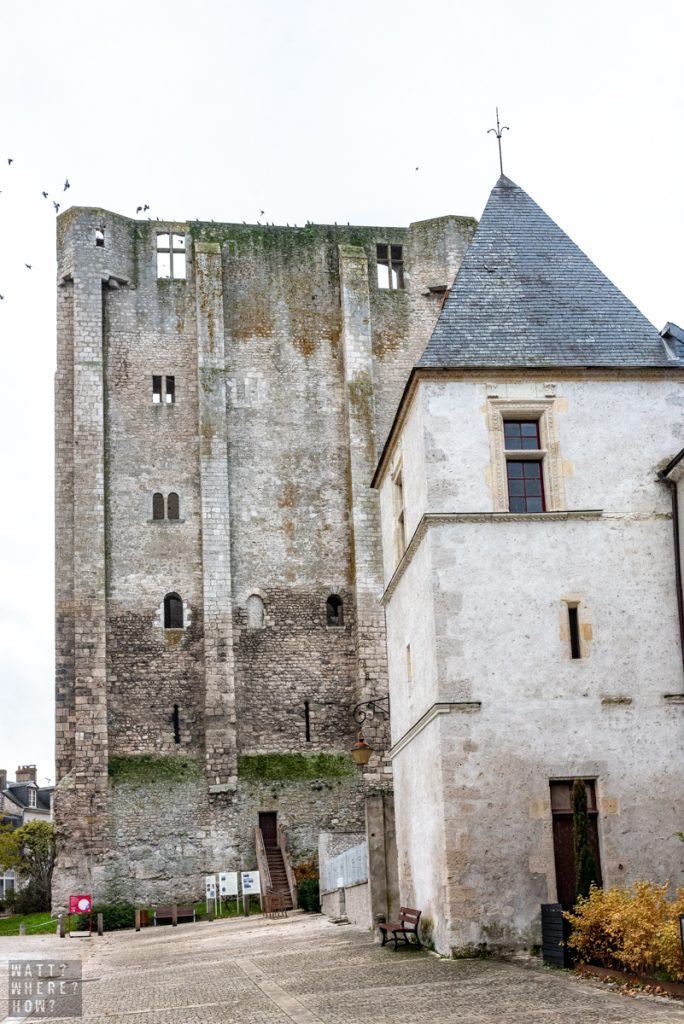Beaugency is a small French town or commune in the Loire ‘Valley of the Kings,’ dating back to the Middle Ages.
Set on the banks of the Loire River and watched over by a medieval tower, Tour Cesar, this sleepy commune has a dramatic past that makes it well worth a detour off the 130 km/hour toll road to Orlean.

If you love history, imagine a town that played a massive part in the birth of the Plantagenet dynasty, was a battleground for Joan of Arc, and even saw heavy French Resistance action in World War 2. Its defensive position overlooking the only river crossing in the region ensured it was often fought over.
Walk the Pont de Beaugency
Bridging the Loire River at Beaugency gave the town a strategic strength for local lords, with the county of Blois on one side and Orleans on the other. It also raised much-needed funds, with the bridge also tolled for passage through the region. The original wooden bridge dates back to the 11th century and is first mentioned in the will of Simon II, Lord of Beaugency, in the 12th century. By the 14th century, after being washed away by floods, the wooden structure was replaced by stone, along with drawbridges and defensive towers.

The river crossing saw many great battles, including the Battle of Beaugency, 16–17 June 1429, which was a short-lived fight that occurred after the Siege of Orleans. In the skirmish with the English, Joan of Arc and Duke John II of Alençon were able to free the village of the invaders, who sought refuge within the town’s medieval keep (which still remains today). After further bombardment from the French, the English surrendered.

In World War 2, the bridge was a target for Allied bombers, with several arches destroyed. The retreating Germans also mined the bridge to hamper General Patton’s advance. Today, the Pont de Beaugency, though appearing to be an ancient structure, dates back to 1946 and offers a picturesque entree into the town of Beaugency.

Stay at Hôtel de Ville
The Hotel de Ville Beaugency is the former town hall and is now a hotel. Of note is a plaque marking the liberation of the town by a combined force of George Patton’s US Army and the French Resistance just 72 days after D-Day.

Live history at the Château de Beaugency
The defensive center of the town is the 11th-century Château de Beaugency. Its keep is basically an empty shell, but in the 15th century, today’s surrounding chateau was built by Jean Dunois and Jeans d’Orléans-Longuveille, a cardinal and bishop of Orleans. Over the years, it’s been an asylum, and currently, it is home to an immersive multimedia art installation.
See Abbatiale Notre Dame, the church that changed medieval history.
Forming an inner courtyard of sorts with the Chateau, Beaugency’s Notre-Dame Abbey also dates back to the 11th Century. Within its walls, Louis VII (1120 – 18 September 1180), King of the Franks, married Eleanor of Aquitaine, one of Europe’s most powerful women at the time. On March 11, 1152, the Council of Beaugency annulled the marriage right within the abbey.

This led to Eleanor marrying Henry Plantagenet, Duke of Normandy, who went on to become the King of England and the first king of the House of Plantagenet. As Eleanor brought South West France with her as the dowry, it contributed to the start of the 100 Years War. Eleanor wasn’t just the head of the Plantagenets; she was also the mother to Richard the Lion-Heart.
Wander Beaugency’s narrow streets
Being a Medieval town, the streets are very narrow but very walkable. Stroll Rue Du Pont, the bridge street for the town’s best restaurants. Here you’ll find timber-framed maisons, vertical gardens flourishing with primroses, and the most aromatic lavender and rosemary. In what looks like a drainage channel, foot-long freshwater fish swim freely.

Sample Loire dining at Le Relais Du Chateau
Visiting Beaugency in the daytime after the peak season, most restaurants are closed, and the streets are very quiet. At its peak, there is an array of dining options, but today, we have no confusing choices to make as there’s only one place serving. Le Relais Du Chateau is a small French restaurant with dated decor, but don’t let first impressions last.
As one of the only families dining at the time, we tried a delicious, but overpriced pre-fixe menu of pumpkin soup, beef, and potato stew, and an incredibly zesty pie. It’s not Michelin star-worthy, but it’s a good example of regional flavors that help chase away the late-autumn chills.
Bernie, Jess, and Siena Watt are international travelers from NYC and Australia. Explore unique travel ideas from Europe, Asia, Australia, and America.
WHAT?
Beaugency is a small commune or town in the Loire Valley that has a place in history for its oft-fought for bridge across the Loire River.
WHERE?
Beaugency sits on the Loire River between Orleans and Bloise, France. It’s 150km (93 miles) southwest of Paris.
HOW?
Take the turn off the A10 just after Orleans. We saw landmark signage that piqued our interest, and it was worth the detour en route to the Chateau du Chambord.
Follow & Connect with us













